| Article ID | Journal | Published Year | Pages | File Type |
|---|---|---|---|---|
| 4202132 | Osong Public Health and Research Perspectives | 2014 | 5 Pages |
ObjectivesThe clinical importance of Staphylococcus aureus (S. aureus) is attributed to notable virulence factors, surface proteins, toxins, and enzymes as well as the rapid development of drug resistance. The aim of this study was to compare the occurrence of virulence factors produced by S. aureus strains isolated from children in an Iranian referral children's hospital.MethodsThe presence of genes encoding for the enterotoxins A (sea), B (seb), C (sec), D (sed), TSST-1 (tsst), exfoliative toxin A (eta), and exfoliative toxin B (etb) were detected by Multiplex polymerase chain reaction (PCR) using specific primers. In addition, the standardized Kirby-Bauer disc-diffusion method was performed on Mueller-Hinton agar.ResultsIn total, 133 S. aureus isolates were obtained from different patients. Of these S. aureus isolates, 64 (48%) were methicillin-resistant S. aureus (MRSA), and all of these tested positive for the mecA gene. Regarding the classical enterotoxin genes, sea gene (40.6%) was the most prevalent followed by seb (19.6%), tsst (12.8%), eta (11.3%), etb (9%), sed (4.5%), and sec (3%). Among methicillin-susceptible S. aureus (MSSA) isolates, seb and tsst were the more prevalent toxins in comparison with MRSA isolates (p < 0.05), while the frequency of sea, sed, eta, and etb genes were higher among MRSA isolates (p > 0.05).ConclusionIn our study enterotoxin A was produced by 40.6% of the isolates (48% from MRSA and 33% from MSSA isolates) which was higher than in previous reports. According to our results, strict hygiene and preventative measures during food processing are highly recommended.
